Reviews
The Lyon Biennale Responds to the Post-Industrial Economy, Only to Get Lost in Post-Human Reveries
Held in a recently decommissioned washing machine factory, the event tries to grapple with the future of labor.
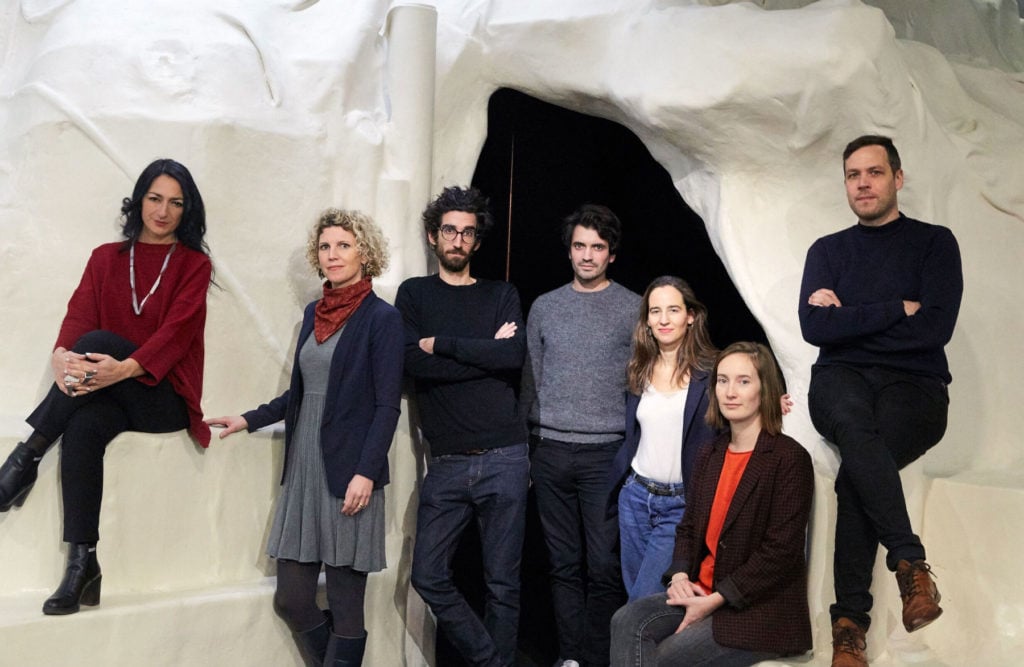
Held in a recently decommissioned washing machine factory, the event tries to grapple with the future of labor.

Terence Trouillot

The 15th edition of the Lyon Biennale is unusual, unique, and complicated—both in its scope and conceptual underpinnings. It is a large-scale, ambitious, and impressive survey that at times feels like it’s standing on shaky ground, struggling to fit a multitude of concepts (and massive artworks) into one open-ended theme. And yet, more often than not, it is able to find its footing within a maze of formidable artworks and complex ideas.
“Là Où Les Eaux Se Mêlent,” the title of the exhibition—a mellifluous translation of “Where Water Comes to Meet Other Water,” a poem by Raymond Carver—is a hazy phrase that serves as the central theme of the biennale, both literally (Lyon is the site where both the Saône and Rhône rivers converge) and metaphorically. As the curators stated in their catalogue essay, the title is meant to suggest “the flow of capital, goods, information, and people that characterizes the times we live in.”
The overarching theme of “water” also lends itself to environmental, ecological, and also more pointedly—as the curators suggest—“biological,” “bacterial,” and even “cosmogonical” (i.e. anything related to the study of the origins of the universe) concerns. This is all to say that this year’s biennale leaves quite a bit of room for interpretation.

Stéphane Calais, Vie et mort de Cristof Yvoré (Hortensia) (2019). Acrylic and graphite on canvas. Courtesy of the artist.
There are a number of works that are either too opaque—like Stéphane Calais’s colorful abstractions of blobs, curves, and lines—or too on the nose. For myself, the latter includes Minouk Lim’s Si tu me vois, je ne te vois pas (If you see me, I don’t see you) (2019), a large installation implanted in the main venue involving an artificial hot spring and leftover shrouds of traditional Korean clothing, which seems merely to combine a symbol of the artist’s own country’s past (South Korea) with an allusion to the past of the site where the work is situated, an old washing machine factory.
![Minouk Lim, Si tu me vois, je ne te vois pas [If you see me, I don’t see you], 2019. Hot water canal, mixed media.. Courtesy of the artist and Tina Kim Gallery](https://news.artnet.com/app/news-upload/2019/10/lyon-Lim-1024x683.jpg)
Minouk Lim, Si tu me vois, je ne te vois pas [If you see me, I don’t see you] (2019). Courtesy of the artist and Tina Kim Gallery.
It is the first Biennale to be conceived and organized by seven different curators: the talented curatorial team from the Palais de Tokyo in Paris. It is the first to not be housed in Sucrière building since 2003, instead finding a new home in the massive 29,000-square-meter Fagor factory in central Lyon—a recently abandoned site.
Is it the first with gender parity and the first to be held across the entire region with associated exhibitions and various programs in and around the city. Because of this last aspect, one of the more exciting and distinctive features of this year’s biennale is its attempt, within a stream of lofty ideas, to ground its curatorial investigation concretely in the social, economic concerns of the city of Lyon.
![Renée Levi, Là où les eaux se mêlent [Where the waters mingle], 2019. Wall painting, dimensions variable. Image courtesy of the artist.](https://news.artnet.com/app/news-upload/2019/10/lyon-Levi.jpg)
Renée Levi, Là où les eaux se mêlent [Where the waters mingle] (2019). Image courtesy of the artist.
As Yoann Gourel, one of the curators of the biennale, mentioned at the press preview, “this is not a neutral site.” The massive Fagor factory is one of the three main venues of the biennale and where most of the artworks are housed: 47 of the 50-odd artists are exhibited here. The other two locales are the Museum of Contemporary Art (MACLyon), and the LPA (Lyon Parc Auto) Cordeliers parking lot in Presqu’île. Fagor, however was previously the place of work for many of the inhabitants of the Gerland neighborhood, where the giant facility sits. The factory closed down only 4 years ago and has since been completely abandoned.
Fagor has a long history that is deeply tied to Lyon’s industrial heritage, providing jobs for almost 2,000 people in the early ’80s. By the early aughts that number shrank to 400. After some uncertainty about its future, the factory was finally sold to Centro Motors in 2015 with the promise that it would become a newly refurbished site for manufacturing electric cars. That plan quickly fell through and left many workers unemployed. The space was left behind, almost unscathed—except for the occasional flurry of graffiti art and broken windows—perfectly ripe for appropriation as an arts and cultural venue.
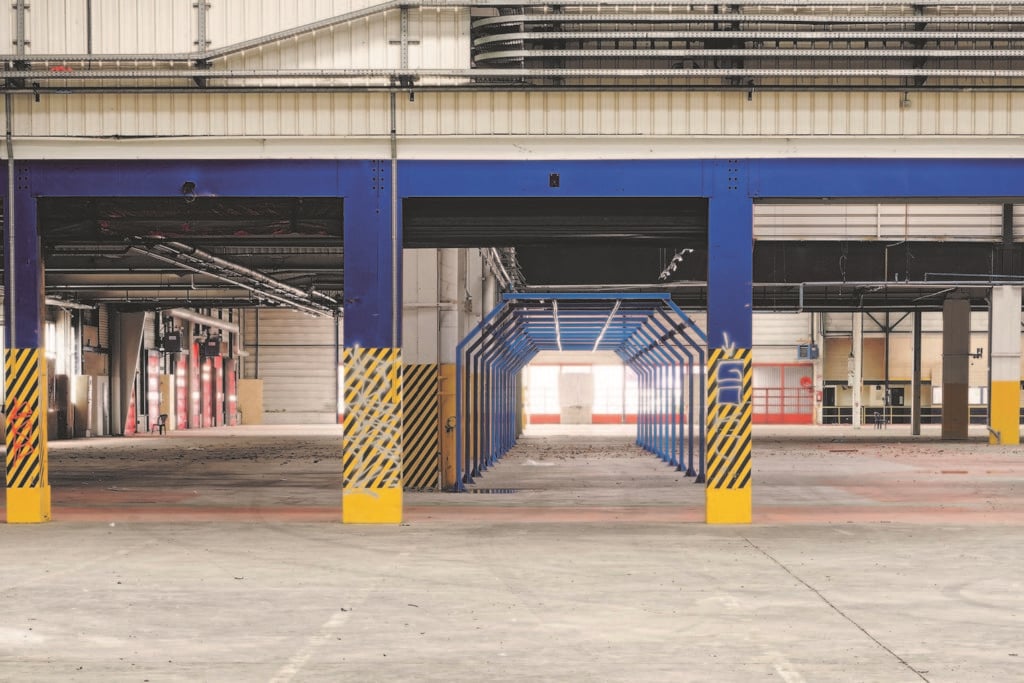
Interior of the Fagor Factory. Courtesy of the Lyon Biennale.
The potential for the event to be read as a case of a wealthy and long-established arts organization swooping in and taking advantage of an unfortunate situation, claiming a space that had its own recent history of economic distress with the false hopes of “revitalizing” the community through arts and culture, has (fortunately) not gone over the heads of these curators. In fact, their stated aim is to shine a bright light on this inherent problematic, mustering thoughtful engagements with the politics, architecture, and history of Fagor.
For this reason, the space is left bare and raw, leaving all traces of what was once a working industrial space: paint markings on the floor, leftover machinery, etc. Additionally, there are no white walls and no bifurcations to separate the works, just four massive open halls where art seems to blend in with its environment, creating a somewhat labyrinthine locale, despite the large expanse these spaces provide.
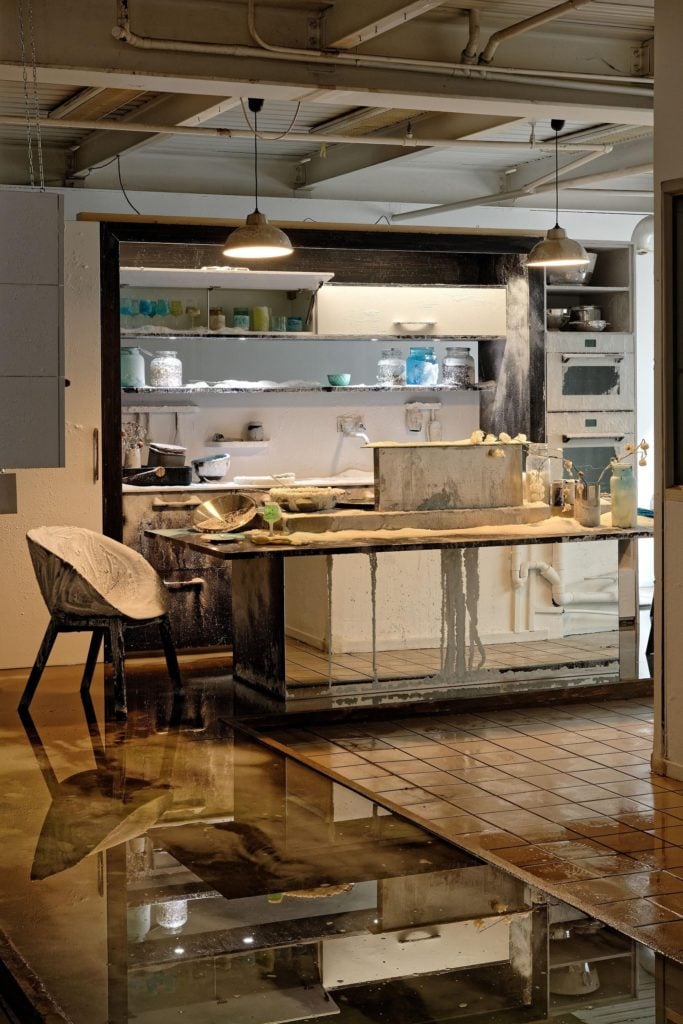
Bianca Bondi, The sacred spring and necessary reservoirs (2019). Mixed media. Courtesy of the artist.
More importantly, the artists were asked to create site-specific works that speak directly to this environment. This is evidenced, for example, by Bianci Bondi’s whimsical The Sacred Spring and Necessary Reservoirs, for which the artist encrusted an existing dilapidated kitchen with mounds of salt that, in reaction with other chemicals, transform the room into a colorful and magical place.
The art world’s presence and economic influence at the site and in the region is itself also a point of focus. Stephen Powers’s Open Door (2019), a giant mural on the facade of Fagor that reads “Warm in Your Memory,” offers a wisp of an indication that the recent loss of jobs and financial instability still haunts the vacant building. Aguirre Schwarz’s Ma mère et son double (My mother and her double) (2019), featured at the entrance of MACLyon, is a video presenting the logos of all the corporate sponsors of the biennale. The corporate emblems appear on the screen and then, after a visual glitch, begin to liquify and slowly drip across the screen—perhaps a tempered remark on the immense flow of capital that has gone into the presentation of expensive art objects and drips of paint.
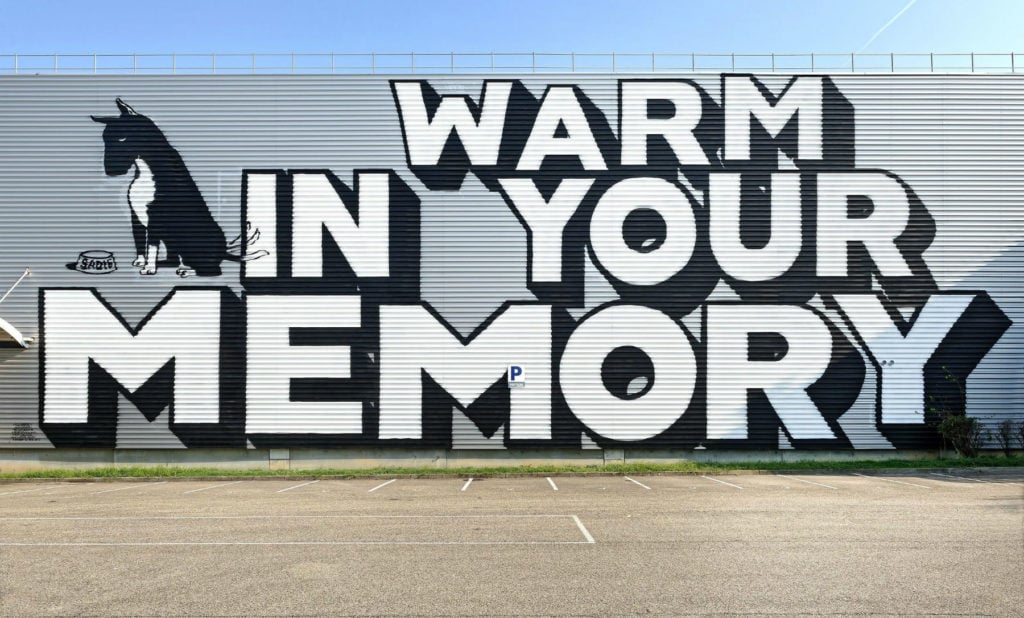
Stephen Powers, Open Door (2019). Courtesy of the artist..
The Lyon-based art collective Bureau des Pleurs (Office of Tears) takes a more direct approach to the area, involving folks from the community in Gerland. In collaboration with François Piron, coordinator of the post-graduate program at the École Nationale Supérieure des Beaux-Arts in Lyon, the group created a large installation inside the former administrative office spaces of Fagor, detailing what it saw as the past, present, and future of the factory. The ground is coated with sand providing a ruined look to the surroundings, but the videos by Carla Adra, a founding member of Bureau des Pleurs, are the centerpiece. After collecting 300 testimonials from the inhabitants of Gerland, the artist reinterprets their stories herself through a series of webcam diary entries to keep her subjects confidentiality.
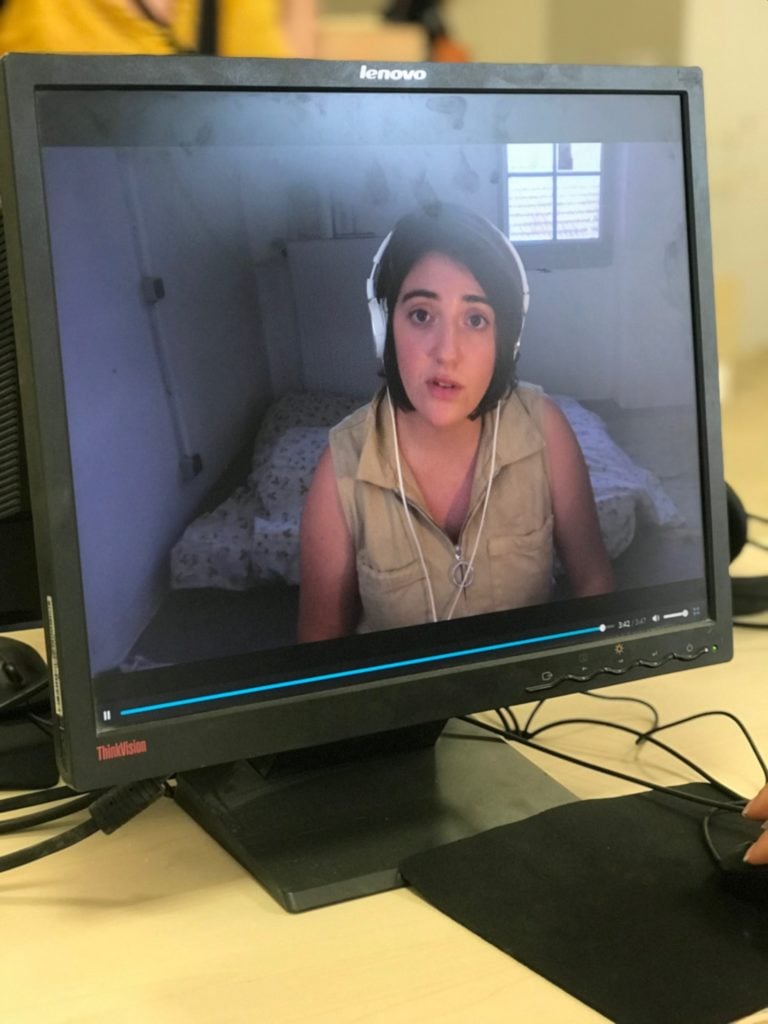
Bureau des Pleurs, Collective installation produced by a Lyon-bases group of artists, 2019. View of a Carla Adra’s contributions, 300 CD, and 300 videos searchable on two computer screens. Photo: Terence Trouillot.
The result is a form of conceptual candor, the stories dutifully and poetically revealing the grievances and injustices felt by this community while also showing how they have been already displaced into art.
Similarly, Argentine artists Julieta Garcia Vazquez and Javier Villa present The Society of Secret Images (2019), a social experiment that invites residents of Gerland to contribute to a collection of images representing “knowledge and sensory experience specific to the Gerland district.” (The work is part of the “Veduta” project, an arts initiative first started in Lyon in 2007 by Adeline Lépine that seeks to engage different urban areas of the city through the convergence of art and social practice, in effect activating different parts of the region through dialogue and artistic explorations.) The Society of Secret Images it installed just outside the Fagor factory, in an empty space. A cone-shaped hole recedes into the wall. Inside, a video of a mouth spews poetic musings, maybe loose descriptions of some of the images collected for the project, which remain invisible to the greater public.
What rings true about most of the works in the show is not only the absence or concealment of the community members themselves, but the deliberate absence of actual human bodies. This may be due the post-humanist bent of the biennale, in some ways reflecting a post-apocalyptic view of its surroundings and a deference towards non-living, inanimate objects. This post-industrial biennial gestures towards a future that sees, at its most basic level, a world in which human labor is quickly dwindling to zero in response to mechanical advancements.
One of the main takeaways of this year’s biennale is a focus not only on the realities and projections of the Anthropocene, but rather a resonance with Donna J. Haraway’s notion of the Chthulucene, a theory that explains our current epoch as a time where living and non-livings things are inextricably linked via social, economic, physical, and emotional bonds. The notion, moreover, suggests relationships in conflict with each other, that need remedying, or more diplomatically, some understanding.
![Le peuple qui manque, Et que demandent-t-ils? À y devenir quelque chose [And what do they ask for? To become something], 2019. Mixed media. Courtesy of the artist.](https://news.artnet.com/app/news-upload/2019/10/lyon-Le-peuple-qui-manque-1024x683.jpg)
Le peuple qui manque, Et que demandent-t-ils? À y devenir quelque chose [And what do they ask for? To become something] (2019). Courtesy of the artist.
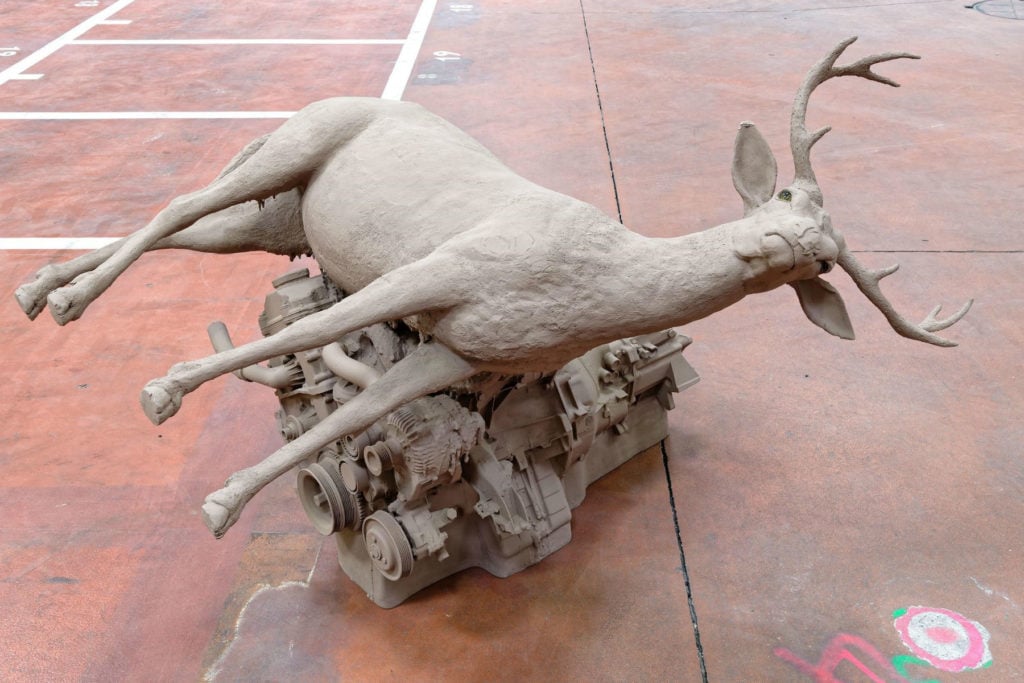
Nico Vascellari, Horse Power (2019). Mixed media. Courtesy of the artist.
Other examples are more expressive, like the chimerical sculptures of the Italian artist Nico Vascellari, fusing animals to car, or the sculptures by French-British artist duo Daniel Dewar & Grégory Gicquel, which present carved works featuring body parts morphing out of wood.
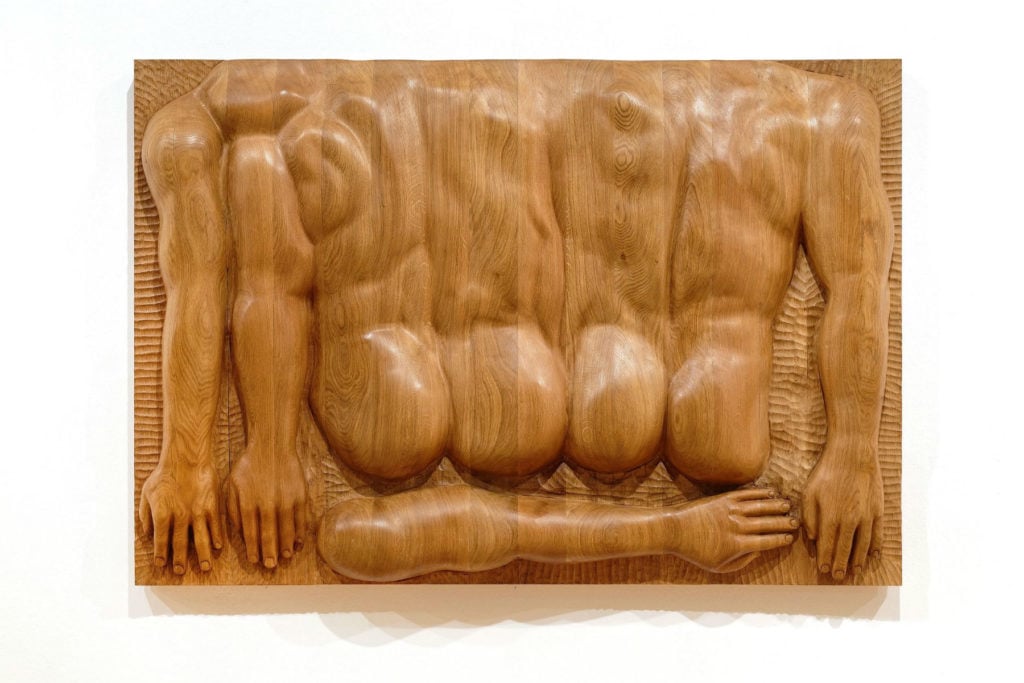
Daniel Dewar & Grégory Gicquem, Oak mural with body fragments (2018). Courtesy of the artists and CLEARING, New York/Bruxelles; Loevenbruck, Paris; Jan Kaps, Cologne.
Most examples, however, are more sinister in their approach. Isabelle’s Andriessen’s sculptures, which she calls “zombie materials,” are irresistibly eerie: amorphous synthetic objects that ooze and decompose on the floor. Thomas Feuerstein’s Prometheus Delivered (2017–2019), an imposing installation that retells the story of the mythological Titan is also menacing. Here a statue of Prometheus is decomposing from stone-eating bacteria, while tubes attached to it try to revive the figure with a mixture of human cells and the same bacteria, to somehow alchemically generate a human liver.
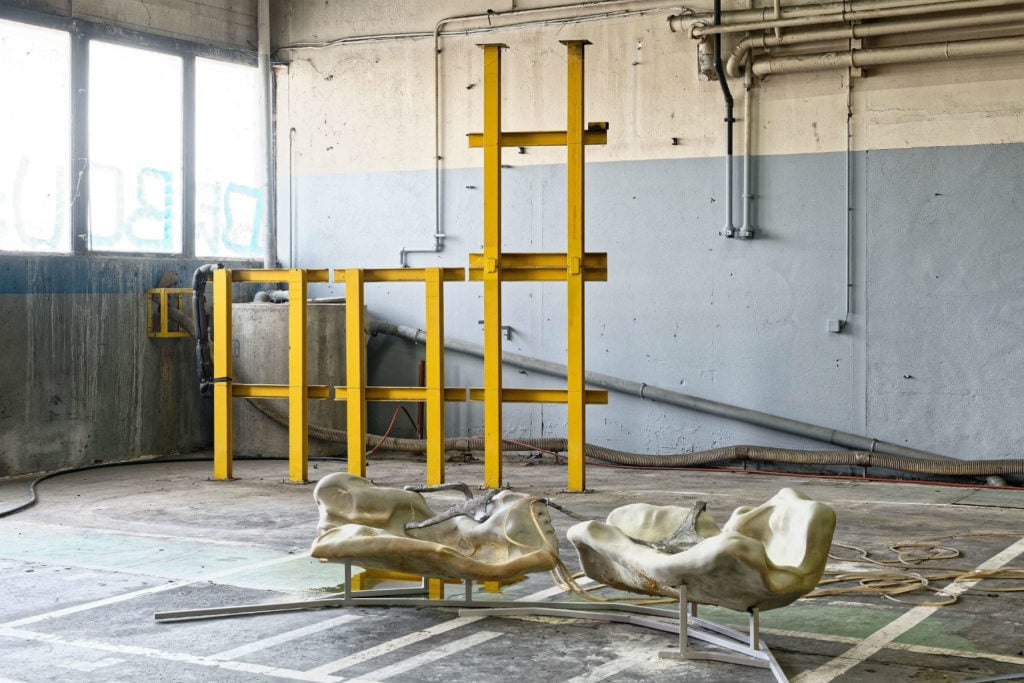
Isabelle Andriessen, Terminal Beach (2018). Courtesy of the artist.
Finally, the Belgian artist Eva L’Houest also offers a discomforting, although alluring, view of hybrid forms. Her video and sculptural work draw fractal and distorted imagery from 3-D scans and MRIs, to create humanoid figures that blend with and move through other objects (e.g. trash, detritus, fences, and plaster sculptures) and space.
A great many of the works in “Là Où Les Eaux Se Mêlent” promote, in however disturbing a way, a fluidity between the mechanical and the human. The implicit post-humanist perspective here tries to insinuate that we must learn to live with this new reality, giving some agency to non-living things. (That blurring of borders is reflected, I’d argue, in the way the show is installed at the Fagor factory, where art and ideas feel ironically crammed into a gigantic open space.)
But in the end this conceptual framework may actually erase the actual, very-human tragedy that this post-industrial site represents. Human greed is not some new philosophical condition, and machines are still just instruments used by humans on other humans. It’s worth remembering that this history is obscured when the conversation directs us to a new reality of human-machine-nature hybridity.
The 15th Lyon Biennale is on view in Lyon, France, through January 5, 2020.